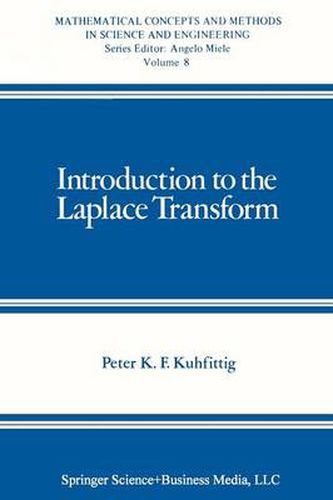Readings Newsletter
Become a Readings Member to make your shopping experience even easier.
Sign in or sign up for free!
You’re not far away from qualifying for FREE standard shipping within Australia
You’ve qualified for FREE standard shipping within Australia
The cart is loading…






This title is printed to order. This book may have been self-published. If so, we cannot guarantee the quality of the content. In the main most books will have gone through the editing process however some may not. We therefore suggest that you be aware of this before ordering this book. If in doubt check either the author or publisher’s details as we are unable to accept any returns unless they are faulty. Please contact us if you have any questions.
The purpose of this book is to give an introduction to the Laplace transform on the undergraduate level. The material is drawn from notes for a course taught by the author at the Milwaukee School of Engineering. Based on classroom experience, an attempt has been made to (1) keep the proofs short, (2) introduce applications as soon as possible, (3) concentrate on problems that are difficult to handle by the older classical methods, and (4) emphasize periodic phenomena. To make it possible to offer the course early in the curriculum (after differential equations), no knowledge of complex variable theory is assumed. However, since a thorough study of Laplace. transforms requires at least the rudiments of this theory, Chapter 3 includes a brief sketch of complex variables, with many of the details presented in Appendix A. This plan permits an introduction of the complex inversion formula, followed by additional applications. The author has found that a course taught three hours a week for a quarter can be based on the material in Chapters 1, 2, and 5 and the first three sections of Chapter 7. If additional time is available (e.g., four quarter-hours or three semester-hours), the whole book can be covered easily. The author is indebted to the students at the Milwaukee School of Engineering for their many helpful comments and criticisms.
$9.00 standard shipping within Australia
FREE standard shipping within Australia for orders over $100.00
Express & International shipping calculated at checkout
This title is printed to order. This book may have been self-published. If so, we cannot guarantee the quality of the content. In the main most books will have gone through the editing process however some may not. We therefore suggest that you be aware of this before ordering this book. If in doubt check either the author or publisher’s details as we are unable to accept any returns unless they are faulty. Please contact us if you have any questions.
The purpose of this book is to give an introduction to the Laplace transform on the undergraduate level. The material is drawn from notes for a course taught by the author at the Milwaukee School of Engineering. Based on classroom experience, an attempt has been made to (1) keep the proofs short, (2) introduce applications as soon as possible, (3) concentrate on problems that are difficult to handle by the older classical methods, and (4) emphasize periodic phenomena. To make it possible to offer the course early in the curriculum (after differential equations), no knowledge of complex variable theory is assumed. However, since a thorough study of Laplace. transforms requires at least the rudiments of this theory, Chapter 3 includes a brief sketch of complex variables, with many of the details presented in Appendix A. This plan permits an introduction of the complex inversion formula, followed by additional applications. The author has found that a course taught three hours a week for a quarter can be based on the material in Chapters 1, 2, and 5 and the first three sections of Chapter 7. If additional time is available (e.g., four quarter-hours or three semester-hours), the whole book can be covered easily. The author is indebted to the students at the Milwaukee School of Engineering for their many helpful comments and criticisms.